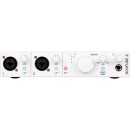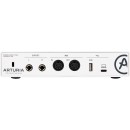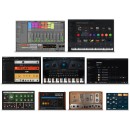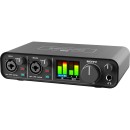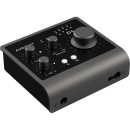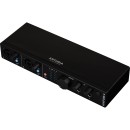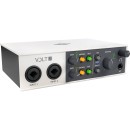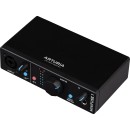Arturia MiniFuse 2 Portable 2x2 USB Type-C Audio/MIDI Interface Review
- 2-in/2-out USB Type-C audio interface
- 24-bit/192kHz audio resolution
- 2 front-panel combo inputs with mic/line/instrument level
- 2 TRS balanced outputs
- 1 headphone output with level control
- MIDI I/O for connecting external MIDI gear
- Phantom power for condenser microphones
- Direct monitoring with mix control
- Rugged metal chassis for durability
- Includes a comprehensive software bundle
Specifications, Advantages, and Disadvantages
The Arturia MiniFuse 2 is a highly versatile and portable 2x2 USB Type-C Audio/MIDI Interface, ideal for musicians, producers, and content creators seeking high-quality audio recording and playback. With its compact design, the MiniFuse 2 is perfect for on-the-go use, fitting easily into any setup whether at home or in a mobile studio environment. It features two combo inputs that accommodate both XLR and 1/4" connections, allowing for flexible recording of microphones, instruments, and line-level sources.
Equipped with professional-grade 24-bit/192kHz audio resolution, the MiniFuse 2 ensures crystal-clear sound quality, capturing every nuance of your performance. The interface also includes a set of MIDI in and out ports, enabling seamless integration with MIDI-compatible devices for expanded creative possibilities. Furthermore, the USB Type-C connectivity ensures fast, reliable data transfer and broad compatibility with modern computing devices.
The Arturia MiniFuse 2 also comes bundled with an impressive software package, including Arturia's Analog Lab Intro, Ableton Live Lite, and a selection of effects from Arturia's FX Collection. This robust software suite provides users with a comprehensive toolkit for music production, mixing, and sound design. With its blend of high-quality hardware, extensive software, and user-friendly design, the Arturia MiniFuse 2 is an excellent choice for anyone looking to enhance their audio production capabilities.
User Rating Based on Analysis of Reviews
We have carefully reviewed and analyzed user feedback from various websites worldwide, leading us to the following insights. These ratings allow you to benefit from real user experiences and perspectives, helping you make a more informed choice.
Purchase Value
85% of users expressed satisfaction with the purchase value of the Arturia MiniFuse 2 Audio Interface. They appreciated the combination of price and features, highlighting it as an excellent entry-level interface that delivers professional quality sound without breaking the bank. Many users felt they received a lot of value for their money, especially with the included software package.
15% of users were dissatisfied with the purchase value, mainly due to expectations of higher-end features that were not present. Some users felt that the pricing could be more competitive in comparison to similar products with slightly better specifications.
Quality of Materials
80% of users were satisfied with the quality of materials used in the MiniFuse 2, noting that it felt sturdy and reliable. They praised its solid build and compact design, which made it suitable for both home studios and on-the-go recording setups.
20% of users expressed dissatisfaction with the quality of materials, citing issues such as plastic components that felt less durable. A few users reported concerns about the longevity of the interface, feeling that it could be prone to wear and tear over time.
Ease of Use
90% of users found the Arturia MiniFuse 2 to be very user-friendly. They appreciated its intuitive interface, straightforward controls, and easy setup process. Many users, especially beginners, praised its simplicity and the seamless integration with various DAWs, making it a great choice for those new to audio recording.
10% of users were dissatisfied with the ease of use, often due to initial setup difficulties or issues with driver installation. Some users felt that the documentation did not provide enough guidance for troubleshooting common problems.
Sound Quality
88% of users were highly satisfied with the sound quality of the MiniFuse 2. They appreciated the clear and crisp audio output, with many highlighting the low noise preamps and high headroom as standout features. Users noted that recordings maintained a professional quality, suitable for both voice and instrument inputs.
12% of users expressed dissatisfaction with the sound quality, mentioning issues such as occasional audio glitches or interference. Some users felt that the output level was not as robust as expected, requiring additional gain adjustments during recordings.
Portability
92% of users were satisfied with the portability of the MiniFuse 2, praising its compact size and lightweight design. Users found it easy to transport, making it ideal for mobile recording setups or small home studios. Many appreciated how it fit easily into backpacks or laptop bags.
8% of users were less satisfied with the portability, mainly due to concerns about potential durability issues when transported frequently. Some felt that while it was small, additional protective casing was necessary to ensure it remained undamaged.
Software Compatibility
87% of users were pleased with the software compatibility of the MiniFuse 2, noting that it worked well with multiple digital audio workstations (DAWs) across both Windows and Mac systems. Users appreciated the seamless integration and the included software suite, which enhanced their recording experience.
13% of users were dissatisfied with software compatibility, often due to issues with specific DAW integration or driver conflicts. Some users experienced difficulties in accessing the full range of features or encountered bugs with certain software updates.
Customer Support
75% of users reported positive experiences with Arturia's customer support. They found the support team responsive and helpful in resolving technical issues or providing guidance on product use. Several users highlighted quick turnaround times for queries.
25% of users were dissatisfied with customer support, citing delays in response times or lack of resolution for complex issues. Some users felt that the support resources were limited, particularly for less common technical problems.
Design
83% of users were satisfied with the design of the MiniFuse 2, appreciating its sleek and modern aesthetic. Users liked the layout and accessibility of controls, as well as the visual design which complemented their studio setups.
17% of users expressed dissatisfaction with the design, often due to personal preferences for different control layouts or aesthetic choices. Some users felt that certain design elements, like LED indicators, could be improved for better visibility.
Durability
78% of users were satisfied with the durability of the MiniFuse 2, stating that it withstood regular use without significant wear. Many users felt confident in the build quality, trusting it to handle minor knocks and bumps.
22% of users expressed concerns about durability, mentioning issues like loose knobs or connections after extended use. Some users felt that certain components were not robust enough for frequent transportation or heavy use.
Latency
86% of users were satisfied with the low latency performance of the MiniFuse 2. They noted minimal delay when monitoring recordings, which was crucial for real-time audio production. Users appreciated the smooth operation even with complex setups.
14% of users experienced dissatisfaction with latency, citing occasional lag in specific DAW environments or with certain software plugins. Some users required additional adjustments to optimize performance, which they found cumbersome.
Input/Output Options
82% of users were content with the input/output options available on the MiniFuse 2. They appreciated the flexibility provided by the multiple ports, which accommodated various recording needs from microphones to instruments.
18% of users were dissatisfied with the input/output options, feeling that additional ports or expanded functionality would be beneficial. Some users needed more connectivity for complex setups, which the interface did not provide.
Driver Stability
84% of users were satisfied with the stability of the MiniFuse 2 drivers, noting consistent performance with few to no crashes. Users appreciated the reliability of the drivers, which allowed for uninterrupted recording sessions.
16% of users experienced dissatisfaction with driver stability, often encountering occasional crashes or compatibility issues with certain operating systems. Some users expressed frustration at needing frequent driver updates to maintain stability.
Installation Process
88% of users had a positive experience with the installation process of the MiniFuse 2. They found it straightforward and quick, with clear instructions that guided them through setup efficiently. Many users appreciated the plug-and-play capability.
12% of users were dissatisfied with the installation process, citing challenges with downloading necessary drivers or software. Some encountered issues that required additional technical support, which complicated the initial setup.
Aesthetic Appeal
85% of users appreciated the aesthetic appeal of the MiniFuse 2, noting its modern and attractive design. Users felt that it complemented their studio setups and added a professional touch to their recording environment.
15% of users were less impressed with the aesthetic appeal, with personal preferences differing in terms of design style. Some users desired a more traditional or minimalistic look, which the MiniFuse 2 did not provide.
Connectivity
83% of users were satisfied with the connectivity options of the MiniFuse 2. They appreciated the USB-C connection, which provided fast data transfer speeds and compatibility with modern devices. Users found it easy to integrate into their existing setups.
17% of users expressed dissatisfaction with connectivity, particularly those who experienced compatibility issues with older hardware. Some users felt that additional connection options would enhance flexibility in different recording environments.
Compatibility with Instruments
87% of users were pleased with the MiniFuse 2's compatibility with various instruments. They noted that the preamps handled different input types well, delivering clear and balanced sound for both electric instruments and microphones.
13% of users were dissatisfied with instrument compatibility, mentioning specific issues with particular instrument types or brands. Some users required additional adjustments or settings to achieve optimal sound, which they found inconvenient.
Preamp Quality
89% of users were satisfied with the quality of the preamps in the MiniFuse 2. They highlighted the low-noise performance and how it enhanced the clarity and detail of their recordings. Users found the preamps to be a strong feature of the interface.
11% of users expressed dissatisfaction with preamp quality, citing specific instances of noise or distortion at higher gain levels. Some users felt that while adequate, the preamps could benefit from additional refinement for critical recording applications.
Headphone Output
80% of users were satisfied with the headphone output quality of the MiniFuse 2, noting clear and powerful sound suitable for monitoring recordings. Users appreciated the dedicated volume control, which allowed for precise adjustments.
20% of users expressed dissatisfaction with the headphone output, often due to insufficient volume or perceived lack of clarity. Some users required more power for high-impedance headphones, which the interface struggled to provide.
Overall Performance
86% of users were satisfied with the overall performance of the MiniFuse 2, considering it a reliable and efficient audio interface for various recording needs. Users praised its consistent operation and the quality of recordings it produced.
14% of users experienced dissatisfaction with overall performance, often due to sporadic technical issues or limitations in specific recording scenarios. Some users felt that while generally good, certain features could be enhanced for superior performance.
In the following sections, we will delve into the detailed specifications of the Arturia MiniFuse 2 Portable 2x2 USB Type-C Audio/MIDI Interface. Our comprehensive review will also cover the advantages and disadvantages of this product, helping you make an informed decision.
Pros:
- Compact and portable design, ideal for mobile recording.
- High-quality preamps with low noise and high headroom.
- USB Type-C connectivity for faster data transfer and reliable connection.
- Includes a suite of software and virtual instruments for added value.
- MIDI I/O allows for integration with other MIDI gear.
- Direct monitoring with no latency.
Cons:
- Limited to 2 inputs and 2 outputs, which may not be sufficient for larger recording setups.
- USB Type-C cable not included, which may require additional purchase.
- No dedicated power supply option, relies solely on USB power.
- Plastic construction may not be as durable as metal alternatives.
- Some users may find the included software bundle unnecessary if they already own similar tools.
General
| Channels of I/O | Analog: 2 Inputs / 2 Outputs |
|---|---|
| Maximum Sampling Rate | 192 kHz / 24-Bit |
| Number of Microphone Inputs | 2 Preamps |
| Input Level Adjustment | 2x Knob |
| Expansion Slots |
The Arturia MiniFuse 2 is a versatile audio interface designed for musicians and producers looking for high-quality sound capture and playback. Show More
Channels of I/O: This specification indicates the number of input and output channels the interface offers. With 2 inputs and 2 outputs, users can connect multiple instruments or microphones simultaneously, making it ideal for small home studios or on-the-go recording setups. The ability to input and output audio signals allows for flexibility in recording and mixing.
Maximum Sampling Rate: The maximum sampling rate of 192 kHz at 24-Bit reflects the interface's capability to capture audio with high fidelity. A higher sampling rate allows for more accurate representation of sound waves, leading to clearer recordings and better overall audio quality. This feature is particularly beneficial for professional audio work and detailed mixing.
Number of Microphone Inputs: Featuring 2 preamps, the MiniFuse 2 can support two connected microphones at once. This is essential for recording vocals, instruments, or podcasts, providing users with the ability to capture multiple sound sources without needing additional equipment.
Input Level Adjustment: The inclusion of 2 knobs for input level adjustment allows users to tailor the gain for each input channel. This feature helps in preventing distortion during recording by ensuring that levels are set appropriately for different sources, leading to cleaner and more balanced recordings.
Expansion Slots: The absence of expansion slots means the MiniFuse 2 is a compact and straightforward solution without the need for additional hardware or upgrades. This simplicity can be advantageous for users who prefer a plug-and-play experience without the complexity of modular expansions.
Signal Processing
| Pad | |
|---|---|
| Gain/Trim Range | Mic/Line/Hi-Z Inputs: 56 dB |
| High-Pass Filter | |
| Solo/Mute |
The specifications of the Arturia MiniFuse 2 Portable 2x2 USB Type-C Audio/MIDI Interface reflect its functionality and design, catering to both amateur and professional users. Show More
Starting with the **Pad**, the absence of this feature means that the MiniFuse 2 does not offer a way to reduce the input level for very loud sound sources. This could be a limitation for some users who need to accommodate high-output microphones or instruments without distortion.
The **Gain/Trim Range** for the Mic/Line/Hi-Z inputs is rated at 56 dB. This range indicates the level of amplification that the interface can provide to incoming signals. A higher gain range allows for better performance with quieter sources, making it versatile for various audio inputs, from microphones to instruments.
The **High-Pass Filter** is not included in this interface, which means users will not have the option to eliminate low-frequency noise or rumble from their recordings. This feature is often useful in professional settings to ensure clarity in the audio signal, particularly for vocals or acoustic instruments.
Lastly, the absence of **Solo/Mute** functionality indicates that users won’t have the ability to isolate or silence individual channels in their mix directly from the interface. This could affect workflow during recording or mixing sessions, as managing audio levels may require additional steps through software rather than on the hardware itself.
Overall, these specifications provide insight into the MiniFuse 2's straightforward design, focusing on essential functionalities while potentially limiting advanced audio management features.
Connectivity
| Analog Audio I/O | 2x Combo XLR-1/4" TRS Balanced/Unbalanced Mic/Line/Hi-Z Input (Front Panel) 2x 1/4" TRS Balanced Line Output 1x 1/4" TRS Unbalanced Headphone Output (Front Panel) |
|---|---|
| Phantom Power | 48 V, Selectable On/Off (Applied to All Inputs) |
| Digital Audio I/O | |
| Host Connection | 1x USB-C |
| Host Connection Protocol | USB 2.0 |
| USB (Non-Host) | 1x USB-A (USB 2.0, Device Connection) |
| Sync I/O | |
| Network I/O | |
| MIDI I/O | 1x DIN 5-Pin Input 1x DIN 5-Pin Output |
The Arturia MiniFuse 2 is designed with a range of specifications that cater to musicians and audio professionals looking for a compact and versatile audio interface. Show More
The **Analog Audio I/O** section outlines the various input and output options available. With 2x combo XLR-1/4" TRS balanced/unbalanced mic/line/Hi-Z inputs on the front panel, users can connect a variety of audio sources, making it suitable for both vocal and instrument recording. The 2x 1/4" TRS balanced line outputs facilitate connection to monitors or external gear, while the 1/4" TRS unbalanced headphone output allows for monitoring directly from the interface. This flexibility in inputs and outputs is essential for a diverse range of recording scenarios.
The **Phantom Power** feature offers 48V phantom power that can be turned on or off for all inputs. This is particularly important for users who need to power condenser microphones, which require phantom power to operate. The ability to easily toggle this feature enhances its usability in various recording situations.
In terms of **Digital Audio I/O**, the MiniFuse 2 does not include this feature, which may limit its integration with digital audio systems. However, the **Host Connection** utilizes a USB-C port with USB 2.0 protocol, ensuring fast and reliable connectivity with computers. Additionally, there is a USB-A (USB 2.0) port for device connections, allowing for the connection of compatible peripherals.
The **MIDI I/O** section indicates that the interface includes a 1x DIN 5-Pin input and output. This allows users to connect MIDI devices such as keyboards and controllers, expanding the interface's functionality for music production and performance. Overall, the Arturia MiniFuse 2 provides a well-rounded set of specifications that cater to both audio recording and MIDI integration, making it a valuable tool for musicians and producers.
Performance
| Frequency Response | Mic Inputs: 20 Hz to 20 kHz ±0.06 dB (Min Gain) Hi-Z Inputs: 20 Hz to 20 kHz ±0.06 dB (Min Gain) Line Inputs: 20 Hz to 20 kHz ±0.05 dB (Min Gain) Line Outputs: 20 Hz to 20 kHz ±0.09 dB Headphone Outputs: 20 Hz to 20 kHz ±0.09 dB |
|---|---|
| Maximum Input Level | Mic Inputs: +9 dBu Hi-Z Inputs: +11.5 dBu Line Inputs: +22 dBu |
| Maximum Output Level | Line Outputs: +12 dBu Headphone Outputs: +11.4 dBu |
| Headphone Output Power | 137 mW into 33 Ohms |
| Impedance | Mic Inputs: 2.5 Kilohms Hi-Z Inputs: 1 Megohm Line Inputs: 16 Kilohms Line Outputs: 94 Ohms Headphone Outputs: 10 Ohms |
| Dynamic Range | Mic/Line/Hi-Z Inputs: 110 dB (A-Weighted) Line Outputs: 107.5 dB (A-Weighted) Headphone Outputs: 104 dB (A-Weighted) |
| THD+N | Mic Inputs: -100 dB (Unweighted, 1 kHz, Typical) Hi-Z Inputs: -91 dB (Unweighted, 1 kHz, Typical) Line Inputs: -100 dB (Unweighted, 1 kHz, Typical) Line Outputs: -101 dB (Unweighted, 1 kHz, Typical) |
| EIN | Mic Inputs: -129 dB A-Weighted |
The specifications of the Arturia MiniFuse 2 Portable 2x2 USB Type-C Audio/MIDI Interface provide critical information about its audio performance and capabilities. Show More
Frequency Response: This indicates the range of frequencies that the interface can reproduce. For all inputs and outputs, the MiniFuse 2 maintains a frequency response from 20 Hz to 20 kHz with minimal deviation, ensuring that it captures the full spectrum of audio frequencies. This is essential for high-quality recordings and playback, as it allows for accurate representation of sound without coloration.
Maximum Input Level: This feature specifies the highest signal level that can be handled by each input type without distortion. Higher values for mic, Hi-Z, and line inputs indicate that the interface can accommodate louder signals, making it suitable for various sources, from soft vocals to powerful electric guitars.
Maximum Output Level: Similar to the input levels, this shows the peak output levels for line and headphone outputs. These levels are crucial for ensuring that the audio can be sent to speakers or headphones without clipping, which could lead to a loss of audio quality.
Headphone Output Power: This specification measures the power delivered to headphones, impacting how loud the audio can get. A value of 137 mW into 33 Ohms is robust, suggesting that the MiniFuse 2 can drive a wide range of headphones effectively, ensuring clear sound reproduction even at higher volumes.
Impedance: The impedance values for inputs and outputs indicate how much resistance the device offers to the audio signal. Lower impedances for mic and Hi-Z inputs suggest they can capture signals from a variety of sources effectively, while the output impedances ensure compatibility with different types of headphones and speakers.
Dynamic Range: This metric reflects the difference between the quietest and loudest sounds the interface can handle without distortion. A dynamic range of up to 110 dB for mic, line, and Hi-Z inputs ensures that the interface can capture subtle nuances in sound, making it ideal for detailed recordings.
THD+N (Total Harmonic Distortion + Noise): This specification indicates the level of distortion and noise present in the audio signal. Lower values, such as -100 dB for mic and line inputs, suggest that the MiniFuse 2 maintains high fidelity in sound reproduction, which is essential for professional audio work.
EIN (Equivalent Input Noise): This measurement shows the inherent noise level of the mic inputs. A value of -129 dB A-Weighted indicates that the interface is very quiet, allowing for clean recordings, especially important when capturing soft sounds or quiet performances.
Overall, the specifications of the Arturia MiniFuse 2 highlight its capabilities to deliver high-quality audio performance, making it a reliable choice for musicians and audio professionals.
Digital Audio
| Sample Rates | 44.1 / 48 / 88.2 / 96 / 176.4 / 192 kHz |
|---|---|
| Sample Rate Conversion | |
| Bit Depths | 24-Bit |
| Latency | Zero-Latency Direct Monitoring |
| Sync Sources | Internal |
The specifications of the Arturia MiniFuse 2 Portable 2x2 USB Type-C Audio/MIDI Interface highlight its capabilities and performance, particularly for audio recording and production.Show More
Sample Rates: The MiniFuse 2 supports a wide range of sample rates, including 44.1 kHz up to 192 kHz. This flexibility allows users to choose the best sample rate for their specific application, whether it's music production, podcasting, or sound design. Higher sample rates can capture more detail and provide better sound quality, making them ideal for professional audio work.
Sample Rate Conversion: This feature indicates that the MiniFuse 2 does not offer sample rate conversion. This means that the interface will operate at the selected sample rate without automatically converting between different rates. Users need to ensure that their audio sources and projects are set to the same sample rate to avoid potential issues.
Bit Depths: The MiniFuse 2 operates at a bit depth of 24-bit. A higher bit depth allows for greater dynamic range and more detailed audio capture, which is especially important in professional audio environments. This results in recordings that are clearer and more accurate, providing more headroom for mixing and post-processing.
Latency: The interface features zero-latency direct monitoring, which means that users can hear their inputs in real-time without any delay. This is crucial for musicians and vocalists who need to perform along with other tracks without experiencing distracting lag.
Sync Sources: The MiniFuse 2 uses an internal sync source, which means that it generates its own timing signals for audio playback and recording. This is standard for many audio interfaces and ensures that the device operates reliably and synchronously with connected equipment.
Audio Storage & Playback
| Memory Card Slot |
|---|
The Arturia MiniFuse 2 Portable 2x2 USB Type-C Audio/MIDI Interface does not include a memory card slot. This feature typically allows users to insert and read memory cards for additional storage or file transfer purposes. In audio interfaces, a memory card slot can be beneficial for recording directly to the card or playing back audio files without relying on a computer's storage. However, the absence of this feature in the MiniFuse 2 indicates that users will need to connect the interface to a computer to manage their audio files, which is common in many portable audio interfaces. Show More
Overall, while a memory card slot can enhance the versatility of an audio interface, the MiniFuse 2 focuses on providing essential connectivity and functionality, ensuring that users can easily integrate it into their existing recording setups without the added complexity of managing external storage.
Compatibility
| OS Compatibility | macOS Windows |
|---|---|
| Required Hardware | Available USB 2.0 Port USB Cable (Included) |
| Internet Connection | Required for Registration, Software/Driver Download |
The Arturia MiniFuse 2 Portable 2x2 USB Type-C Audio/MIDI Interface is designed to be highly compatible with both macOS and Windows operating systems. This means that users can easily integrate the device into their existing setups, whether they are using Apple or PC platforms. Such versatility is crucial for musicians and producers who may work across different environments and need a reliable interface that performs consistently.Show More
For the required hardware, the MiniFuse 2 needs an available USB 2.0 port, which is common on most computers and laptops. This ensures that users can connect the interface without the need for additional hardware upgrades. The inclusion of a USB cable in the package simplifies the setup process, allowing users to connect their devices right out of the box.
An internet connection is mandatory for registration, software installation, and driver downloads. This aspect reflects the modern necessity of online connectivity for hardware devices, as it allows users to access the latest updates and software enhancements, ensuring optimal performance and compatibility with their digital audio workstations (DAWs). Overall, these specifications highlight the MiniFuse 2's focus on user-friendliness and adaptability in various production environments.
Power
| Power Requirements | USB Bus Power |
|---|
The power requirements for the Arturia MiniFuse 2 indicate that it operates using USB Bus Power. This means that the device draws its power directly from the USB connection to your computer or other compatible USB power sources, eliminating the need for an external power supply. This feature is particularly advantageous for users who require portability, as it allows for a streamlined setup without the clutter of additional power cords and adapters.Show More
Using USB Bus Power also ensures that the MiniFuse 2 can be easily used in various environments, such as home studios, live performances, or on-the-go recording sessions. The ability to power the interface through USB ensures compatibility with laptops and other mobile devices, making it an ideal choice for musicians and audio professionals who value convenience and flexibility in their workflow. Overall, this power requirement contributes to the MiniFuse 2's appeal as a compact, user-friendly audio interface.
Physical
| Anti-Theft Features | Kensington Security Slot |
|---|---|
| Dimensions | 7.9 x 3.9 x 1.6" / 20.1 x 9.9 x 4.1 cm |
| Weight | 1.1 lb / 0.5 kg |
The Arturia MiniFuse 2 comes equipped with various features that enhance its usability and security. One of these features is the Anti-Theft Features, specifically the inclusion of a Kensington Security Slot. This slot allows users to attach a security cable, providing a level of protection against theft, particularly useful in public or shared spaces where the interface may be left unattended.Show More
In terms of Dimensions, the MiniFuse 2 measures 7.9 x 3.9 x 1.6 inches (20.1 x 9.9 x 4.1 cm). Its compact size makes it highly portable, allowing musicians and audio professionals to easily transport it for on-the-go recording or performance setups. The small footprint ensures it can fit into most bags without taking up much space.
The Weight of the MiniFuse 2 is 1.1 lb (0.5 kg), which further emphasizes its portability. A lightweight design is beneficial for users who travel frequently or need to set up and dismantle their equipment quickly. This combination of dimensions and weight ensures that the MiniFuse 2 is not only functional but also convenient for various musical and recording scenarios.
Packaging Info
| Package Weight | 1.29 lb |
|---|---|
| Box Dimensions (LxWxH) | 9 x 5.3 x 1.9" |
The Package Weight of the Arturia MiniFuse 2 is 1.29 lb, which indicates the total weight of the product when packaged for shipping. This relatively lightweight design makes the MiniFuse 2 an excellent choice for musicians and audio professionals who require portability without sacrificing performance. A lighter package can make it easier to transport, whether for live performances, studio sessions, or traveling.Show More
The Box Dimensions of 9 x 5.3 x 1.9 inches provide insight into the size of the packaging. These dimensions suggest a compact design, allowing for easy storage and transport. The slim profile is particularly beneficial for those with limited space or who prefer to keep their gear organized. Moreover, the compact box size means it can fit comfortably in a backpack or carry-on bag, making it a practical choice for creators on the go.
Customer Images
Videos
Customer Questions
How do I install the drivers for the Arturia MiniFuse 2 on Windows?
To install the drivers for the Arturia MiniFuse 2 on Windows, download the MiniFuse Control Center from the Arturia website. Run the installer and follow the on-screen instructions to complete the installation.
Why is my Arturia MiniFuse 2 not being recognized by my computer?
Ensure that the USB Type-C cable is securely connected to both the MiniFuse 2 and your computer. Try using a different USB port or cable. Also, make sure you have installed the necessary drivers and firmware updates.
How can I connect my MIDI keyboard to the Arturia MiniFuse 2?
To connect your MIDI keyboard, use a standard MIDI cable to connect the MIDI OUT port on your keyboard to the MIDI IN port on the MiniFuse 2. Ensure your DAW is set to receive MIDI input from the MiniFuse 2.
What should I do if I'm experiencing latency issues with the Arturia MiniFuse 2?
To reduce latency, open the MiniFuse Control Center and adjust the buffer size to a lower setting. Additionally, ensure that you are using the latest drivers and that your computer meets the system requirements.
How do I set up phantom power for my condenser microphone on the Arturia MiniFuse 2?
To enable phantom power, press the +48V button on the front panel of the MiniFuse 2. This will provide the necessary power for condenser microphones.
Why am I not getting any sound from my headphones when connected to the Arturia MiniFuse 2?
Check the headphone volume knob on the front panel and make sure it is turned up. Also, ensure that the headphone output is selected in your DAW's audio settings.
Can I use the Arturia MiniFuse 2 with an iPad or iPhone?
Yes, you can use the MiniFuse 2 with an iPad or iPhone by using a compatible USB Type-C to Lightning adapter. Ensure your iOS device supports USB audio interfaces.
How do I update the firmware on the Arturia MiniFuse 2?
To update the firmware, open the MiniFuse Control Center on your computer. If a firmware update is available, you will be prompted to update. Follow the on-screen instructions to complete the update.
What should I do if my DAW is not receiving input from the Arturia MiniFuse 2?
Ensure that the MiniFuse 2 is selected as the input device in your DAW's audio settings. Check the gain knobs and input levels on the MiniFuse 2 to ensure they are turned up and receiving signal.
How can I get the best audio quality from the Arturia MiniFuse 2?
To achieve the best audio quality, use high-quality cables and ensure proper gain staging. Keep the input gain knobs at appropriate levels to avoid clipping, and use the MiniFuse Control Center to optimize your settings.
Comparison
← SWIPE THE TABLE TO SEE MORE →
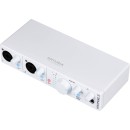
Arturia MiniFuse 2 |
VS | |||||
|---|---|---|---|---|---|---|
| Analog: 2 Inputs / 2 Outputs |
Channels of I/O |
Analog: 2 Inputs / 2 Outputs |
Analog: 2 Inputs / 2 Outputs at 96 kHz |
Analog: 4 Input / 4 Output Digital: Digital I/O |
Analog: 2 Inputs / 2 Outputs |
Analog: 1 Input / 2 Outputs |
| 192 kHz / 24-Bit | Maximum Sampling Rate | 192 kHz / 24-Bit | 96 kHz / 24-Bit | 192 kHz / 24-Bit | 192 kHz / 24-Bit | 192 kHz / 24-Bit |
| 2 Preamps | Number of Microphone Inputs | 2 Preamps | 1 Preamp | 2 | 2 Preamps | 1 Preamp |
| 2x Combo XLR-1/4" TRS Balanced/Unbalanced Mic/Line/Hi-Z Input (Front Panel) 2x 1/4" TRS Balanced Line Output 1x 1/4" TRS Unbalanced Headphone Output (Front Panel) |
Analog Audio I/O |
2x Combo XLR-1/4" TRS Balanced/Unbalanced Mic/Line/Hi-Z Input 1x 1/4" TRS Unbalanced Headphone Output 2x 1/4" TRS Balanced Line Output (DC-Coupled) 2x RCA TS Unbalanced Line Output |
1x Combo XLR-1/4" TRS Balanced Mic/Line Input 1x 1/4" TRS Unbalanced Hi-Z Input (Front Panel) 2x 1/4" TRS Balanced Monitor Output 1x 1/4" TRS Unbalanced Headphone Output (Front Panel) 1x 1/8" / 3.5 mm TRS Unbalanced Headphone Output (Front Panel) |
2x Combo XLR-1/4" TRS Balanced/Unbalanced Mic/Line/Hi-Z Input (Front Panel) 2x 1/4" TRS Balanced/Unbalanced Line Input 4x 1/4" TRS Balanced Line/Monitor Output 2x 1/4" TRS Unbalanced Headphone Output (Front Panel) |
2x Combo XLR-1/4" TRS Balanced/Unbalanced Mic/Line/Hi-Z Input (Front Panel) 2x 1/4" TRS Balanced Monitor Output 1x 1/4" TRS Unbalanced Headphone Output (Front Panel) |
1x Combo XLR-1/4" TRS Balanced/Unbalanced Mic/Line/Hi-Z Input (Front Panel) 2x 1/4" TRS Balanced Line Output 1x 1/4" TRS Unbalanced Headphone Output (Front Panel) |
| 1x USB-C | Host Connection | 1x USB-C | 1x USB-C | 1x USB-C | 1x USB-C | 1x USB-C |
| macOS Windows |
OS Compatibility |
macOS 10.11 or Later Windows 7 or Later 9 or Later |
macOS 10.11.6 or Later macOS 11.1 or Later Windows 7 or Later 6 or Later iPadOS |
macOS 10.13 or Later (64-Bit Only) Windows 8.1 or Later (64-Bit Only) |
macOS 10.14 or Later Windows 10 (64-Bit Only) 14 or Later iPadOS 14 or Later |
macOS Windows |
| USB Bus Power | Power Requirements | USB Bus Power | USB Bus Power | USB Bus Power | AC/DC Power Adapter (Not Included) or USB Bus Power | USB Bus Power |
